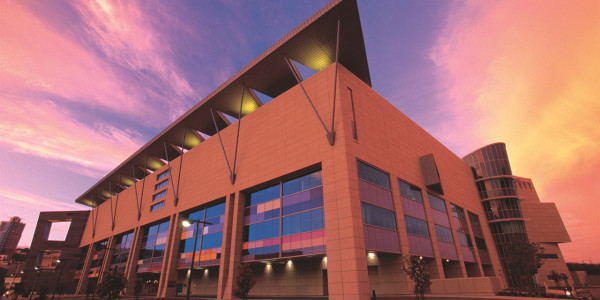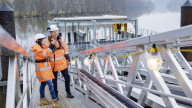As the Renewable Energy sector expands, Higgins brings a wealth of experience to new energy projects. This comes from over 20 years’ experience in wind energy works infrastructure.
Higgins has been head civil contractor on five of New Zealand’s largest wind farms. The team has designed, constructed and delivered civil works infrastructure with output totaling 560MW of wind generation. Higgins has a track record of working collaboratively with clients and developers to manage risk and deliver to client objectives. This is done with the assurance of extensive Fletcher supply chain resources and expertise through Fletcher sister companies including Brian Perry Civil, Firth and Fletcher Reo.
Higgins is also experienced in providing formal early contractor involvement including civil design review, material analysis, pavement and concrete mix design, environmental and traffic management planning, risk assessment, construction planning, specification and cost review.

Forman Commercial Interiors (FCI) is a market leader in interiors construction, with specific capability in suspended ceilings, internal and aluminium partitioning, carpentry and access floors.
Forman Commercial Interiors (FCI) is a market leader in interiors construction, with specific capability in suspended ceilings, internal and aluminium partitioning, carpentry and access floors.
As a member of the Fletcher Construction family of businesses, FCI undertakes work for both Fletcher and other contractors.
FCI works closely with key partners and suppliers to deliver value engineered solutions for clients, on time and to budget.




You’d be hard pressed to find another New Zealand-made product with the sheer market coverage of Winstone Wallboards' (WWB) iconic GIB brand.
You’d be hard pressed to find another New Zealand-made product with the sheer market coverage of Winstone Wallboards' (WWB) iconic GIB brand.
A household name since way back, this impressive brand loyalty is part of the reason WWB is now set to more than double its output with the construction of a large new factory at Tauriko Business Estate in Tauranga. The land size for the new plant is 12.8 hectares, making it two-and-a-half times bigger than the company’s current five-hectare Auckland site, and it will provide up to 100 jobs.
The new plant, being built by our Buildings, Brian Perry Civil and Higgins teams, will be almost 67,000m2 in total floor area including a five-storey high process plant feeding materials to the plasterboard production line and a distribution warehouse.
Higgins has been responsible for the delivery of drainage, water reticulation, pavement construction, kerbs and footpaths and asphalt.
The state-of-the-art, high-speed plant will have the latest international innovations in plasterboard manufacturing technology and automation.
The new plant has been designed with sustainability in mind, with extensive recycling capability for water and waste. There will be onsite recycling and reuse of process wastewater with up to 10% waste board able to be recycled back through the plant into new board. It will also have a 50,000 tonne gypsum storage shed allowing larger, more efficient cargo ships to deliver gypsum from international suppliers.
The $400 million operation, which started construction in January 2021, is expected to bring significant economic benefit to the region as part of the Tauriko Business Estate, which, at 200 hectares, could be Australasia’s biggest industrial subdivision when completed.
| Client | Fletcher Building - Winstone Wallboards |
|---|---|
| Budget | $400 million |
| Completed | September 2023 |




Tisa Rua is a 10-storey mixed-use development in the heart of Waigani, Port Moresby.
Tisa Rua is a 10-storey mixed-use development in the heart of Waigani, Port Moresby.
The project involves a new multi-storey development with the construction of a nine-level tower with retail shops and restaurants on the ground and podium floors, seven floors of commercial office space for lease, and residential spaces with services and amenities on the ninth floor.
| Client | Teachers Savings and Loan (TSL) |
|---|---|
| Completed | March 2023 |


The New Zealand International Convention Centre (NZICC) will be New Zealand’s pre-eminent event venue. Once complete, it will draw audiences from around the globe to experience this country’s unique culture, unforgettable landscapes and innovative business approach.
We are thrilled to partner with SkyCity to realise their vision for a truly world-class facility. Fletcher Construction is designing and building the 32,500m2 NZICC, the five-star, 300-room Horizon Hotel, the retail laneway linking Nelson and Hobson Streets, and the accompanying 1327 carparks.
The project is already providing a huge boost to the Auckland construction market. Once complete, the NZICC and Horizon Hotel will contribute many more jobs across conventions, hospitality, retail and food and beverage.
The NZICC’s exterior will feature the two largest pieces of public art ever created in this country. The works, by New Zealand artists Sara Hughes and Peata Larkin, will span a total of 5,760sqm once fully installed. They comprise of Sarah Hughes’ 550 painted glass panels that wrap around the top level and Peata Larkin’s 13,500 terracotta tiles that form a 31-metre-high perimeter wall alongside the laneway shared with Horizon Hotel.
Fit-out of the neighbouring Horizon Hotel is underway and a 30-metre-long airbridge connects it to SkyCity on the opposite side of Hobson Street. In future, this will create an undercover link across three city blocks to Aotea Station on Albert Street.
The new NZICC and Horizon Hotel will be built together, providing a huge boost to the Auckland construction market and kick-starting a five-year inner city building boom. Many more jobs will be created across conventions, hospitality, retail, gaming and food and beverage once both the NZICC and the new hotel are operational.
The NZICC will be the largest purpose-built convention centre in the country, capable of hosting conventions of around 3000 people, or one-off events of up to 4000 people on the exhibition floor. The NZICC’s exhibition hall alone will be five times larger than the current largest exhibition hall in the country – SKYCITY Convention Centre’s New Zealand Room.
| Client | New Zealand International Convention Centre and SkyCity Entertainment Group |
|---|---|
| Budget | $700 million |
| Completed | Under construction |






The Commercial Bay development for Precinct Properties delivered a world-class retail, commercial and dining precinct and a striking 39-storey tower that attracts workers, shoppers and diners to its stunning waterfront location and provides Auckland with the downtown hub it has long craved.
Built on the former Downtown Shopping Centre site at the foot of Queen Street, Commercial Bay’s foundations were constructed alongside the first section of City Rail Link’s underground rail tunnels, which travel underneath Commercial Bay on the way to and from the neighbouring Britomart Station.
At the base of the tower sits a three-level retail precinct unlike anything Auckland has seen before. Here, the traditional closed-in 'mall' design has been replaced with a collection of buildings that open outward – creating the laneways for which Melbourne is renowned.
The laneway design redefines retail in Auckland with global flagship brands, diverse food and beverage offerings and the highest concentration of quality retailers in one central, easily-accessible location.
Commercial Bay is both an icon and a destination - an inspiring place to relax, meet, work and shop. Its rooftop bars and restaurants provide exciting hospitality experiences that maximise the stunning views over the Waitemata Harbour, while its eye-catching urban design creates stronger connections between Queen Street and the Auckland waterfront.
| Client | Precinct Properties |
|---|---|
| Budget | $425 million |
| Completed | June 2020 |






The redevelopment of Gordons Market in Port Moresby is part of the UN Women's Safe City for Women and Girls Programme, set up in 2011.
The redevelopment of Gordons Market in Port Moresby is part of the UN Women's Safe City for Women and Girls Programme, set up in 2011. The aim was to make the markets safer for all who use them, especially women and children.
Fletcher was awarded the contract to design and build a new market facility, admin building, a separate wholesale area and a food court. Crucial to the design of the new market is creating a safe environment for women and children. This means better security and well-lit areas, separate male and female toilet blocks, a safe space for social gatherings, open stairwells, elevated buildings, better drainage and a separate area for rubbish.
Safety of the 3,500 people who will use the facility is of utmost importance. Fletcher engaged a New Zealand company to model the design and perform a full fire engineering report on the building using the fire safety Verification Method C/VM2 to meet New Zealand and Australian Building codes. This included escape and evacuation times, smoke and fire spread and detection and protection.
Gordons Market provides economic benefits to the entire community. It's a place for women's economic empowerment, providing them the means to support their families.
80 percent of vendors at the Port Moresby markets are women and many have no choice but to bring their children to the market with them. The new Gordons Market provides a safe environment for women and their children, free from crime and sexual harassment.
| Client | National Capital District Commission |
|---|---|
| Budget | $12 million |
| Completed | November 2019 |
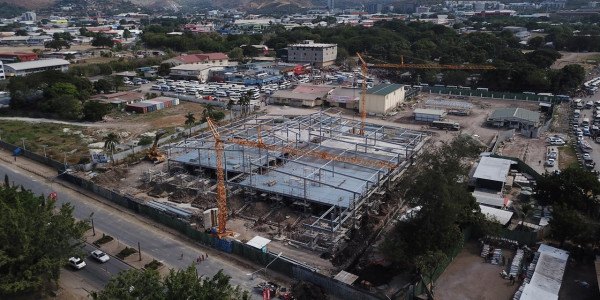

The Department of Corrections is taking a more holistic approach to managing its facilities, with an emphasis on rehabilitation and supporting inmates back into society.
The Department of Corrections is taking a more holistic approach to managing its facilities, with an emphasis on rehabilitation and supporting inmates back into society. When they embarked upon a redevelopment of the 1960’s era East Facility at Auckland Prison (New Zealand’s only maximum security facility), there was no intention to replace like with like. In place of an operating model based on containment of difficult prisoners, Corrections wanted a therapeutic modern facility that contributes to rehabilitative outcomes for prisoners, while continuing to protect the safety and security of staff and the public.
Our work involved the design, construction, finance and maintenance for 25 years of a new maximum security facility, maintenance of the existing Auckland Prison West Facility for approximately 27 years (concurrent with the start of construction of the new facility).
Auckland Prison continued to be operated by Corrections.
We handled the design and construction of the new facility, engaging key technical partners including architects Mode Design and engineering consultants Jacobs and Beca, who all played key roles in the design and delivery of the new men’s prison at ASCF.
| Client | Department of Corrections |
|---|---|
| Budget | $270 million |
| Completed | June 2018 |
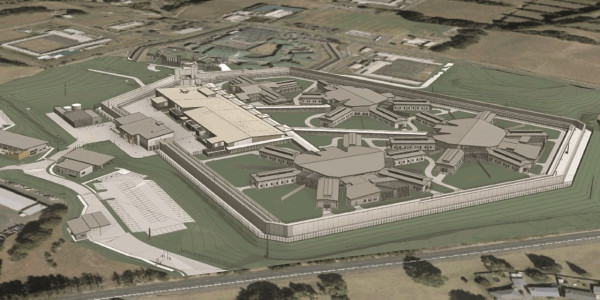

The 25,000m2 Regional Science and Innovation Centre (RSIC), is designed as interactive spaces to promote collaboration and to prepare students for modern open-plan working environments.
The 25,000m2 Regional Science and Innovation Centre (RSIC), is designed as interactive spaces to promote collaboration and to prepare students for modern open-plan working environments. The facility provides a new home for the College of Science across two buildings.
The first building houses specialist teaching and research laboratories for physics, chemistry, astronomy, geography, geology and biological sciences. It has a central atrium for lectures, presentations and other events.
The centre is designed around best building practice to limit energy use, maximise natural light and ventilation and reuse existing materials wherever possible.
The scale and complexity of the build required ISO 9001 and 14001 accreditation, with strict compliance on all procedures and processes.
The 2.5m deep raft slab contains over 7,000m3 of concrete (equivalent to over 1200 truckloads) – representing one of the biggest concrete pours in Christchurch.
The installation and coordination of the complex services is extremely complex – the building contains more than $50 million worth of services to power the high-tech teaching and research laboratories.
Set on a small footprint in the centre of an operational university, works were carefully planned to minimise disruption to the 15,000 students and teaching staff.
| Client | Canterbury University |
|---|---|
| Budget | $134 million |
| Completed | February 2018 |
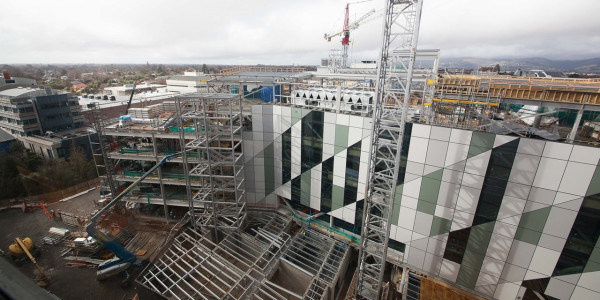

The need for greater collaboration between justice and emergency services was the driver behind the new Christchurch Justice and Emergency Services Precinct. The precinct brings together all justice and emergency services in one purpose-built, world-class precinct in central Christchurch. It is the largest multi-agency government co-location project in New Zealand’s history. An estimated 2000 people work in or use the 40,000m2 precinct daily.
The precinct is the first major public building to be built in Christchurch by the government since the earthquakes of 2010 and 2011. It is made up of three separate buildings: the Justice Building, Emergency Services Building and a separate carpark. The Justice Building houses 19 courtrooms and associated court and legal functions. The Emergency Services Building houses Police, Corrections and the various emergency services and Civil Defence agencies. A purpose-built Emergency Operations Centre (EOC) provides state-of-the-art emergency response capability for local, regional and national incidents.
111 emergency services (South Comms) for NZ Police, NZ Fire Service and St John for the whole of the South Island are co-located in the Emergency Services Building. It houses the first shared 111 call centre for all three agencies in New Zealand.
An Importance Level 4 (IL4) building, the Precinct is specifically designed to remain operational after a 500-year return period earthquake.
All buildings are base-isolated using a combination of lead rubber bearings and PTFE sliders. These are placed within the seismic isolation plane that is formed at the underside of the Level 1 floor. The primary structure is formed with a structural steel two-way movement resisting frame, while a unitised façade system encapsulates the buildings.
| Client | Ministry of Justice |
|---|---|
| Budget | $230 million |
| Completed | September 2017 |
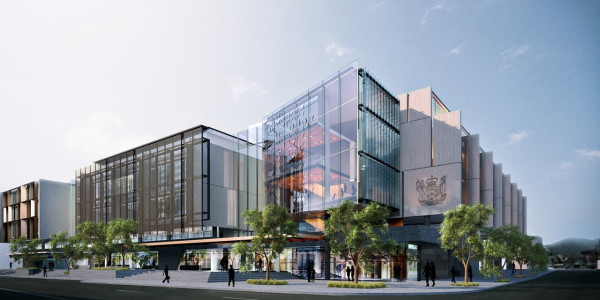

With an aspiration to become the leading provider of biological sciences education in New Zealand, Victoria University sought a state-of-the-art research and teaching facility.
With an aspiration to become the leading provider of biological sciences education in New Zealand, Victoria University sought a state-of-the-art research and teaching facility. We embraced that vision when we were engaged to build the new School of Biological Science at their Kelburn Campus.
The 140m long, five-storey building has a long, low design (a third of which is underground) provides 12,000m² of space for the School of Biological Sciences. Designed to embrace the unique site and its relationship with the topography, campus and the city, the structure houses flexible modern teaching and learning spaces on the upper floors and specialised research laboratories in the basement.
The large structural steel frame building features dampers between the base of the truss and the column to absorb earthquake energy with the column rotating relative to the truss. These dampers are removable and replaceable after a major event.
The building has a ‘keyhole’ through the structure which accommodates an existing operational road. The basement sits below the road level, and the teaching spaces hang above. To ensure that the road remained operational throughout the build, the structure was delivered in three separate sections – north, south and infill sections.
Extensive planning was done to keep the university staff and students safe and to minimise disruption.
| Client | Victoria University |
|---|---|
| Budget | $75 million |
| Completed | June 2017 |
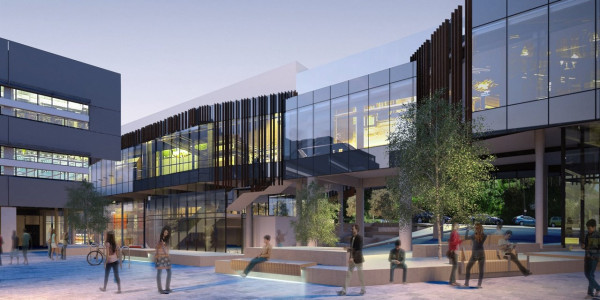

The Canterbury Earthquake National Memorial, He Whakamaumaharatanga o te Ru Whenua, is a project of significance to all New Zealanders.
The Canterbury Earthquake National Memorial, He Whakamaumaharatanga o te Ru Whenua, is a project of significance to all New Zealanders. A place to reflect and remember, it holds special meaning for Cantabrians who experienced these events, but is equally important for the families and friends (both here and overseas) of those who lost their lives or were injured in the earthquakes.
Designed by Slovenian architect Grega Vezjak (whose design was selected from 330 others in an international architecture competition), the memorial comprises a marble wall inscribed with the names of the 185 victims of the 2011 earthquake and a 7m-wide basalt terrace promenade which opens onto the Ōtākaro/Avon River's edge. The 111m long, 3.6m high wall also acknowledges the event's first responders and emergency personnel.
Brian Perry Civil had the privilege of building the Memorial Wall on the south bank of the river. Their work included installation of 70 CFA (Continuous Flight Auger) reinforced piles up to 8m deep and either 600mm or 900mm in diameter. The piles support the wall structure while also retaining the existing roadway and footpath, installation of sheet piles, installation of precast walls and terrace sections, in situ concrete works, marble cladding, basalt paving, electrical works, steel handrails, balustrades, and landscaping.
| Client | Ōtākaro |
|---|---|
| Budget | $7 million |
| Completed | February 2017 |





Visitors to Fiji can sit back and relax at the state-of-the-art Momi Bay Resort.
Visitors to Fiji can sit back and relax at the state-of-the-art Momi Bay Resort. The new five-star Marriott-Branded hotel is located on Fiji's main island Viti Levu. The 250-room hotel was officially opened in April 2017. Fletcher South Pacific Manager Alan Brown said the Marriott at Momi provides a new and unique hotel experience for the Fiji holidaymakers.
We were appointed by the client, Fiji National Provident Fund, to undertake remediation works and complete the 250-room hotel in late 2014. Situated between Fiji’s two most popular resort areas, Denarau and the Coral Coast, Momi Bay offers luxury hotel-style accommodation.
The resort includes three restaurants, two swimming pools, fitness and recreation centres, gift shops, tennis courts and a spa with eight treatment rooms, 114 free-standing bures and 136 standard rooms. Twenty-two of the bures are overwater ones – the first man-made, lagoon-based resort in Fiji.
| Client | Fiji National Provident Fund |
|---|---|
| Budget | $115 million |
| Completed | January 2017 |


132 Halsey Street is a premium apartment complex under construction in Auckland’s rapidly growing Wynyard Quarter.
132 Halsey Street is a premium apartment complex under construction in Auckland’s rapidly growing Wynyard Quarter. Haydn & Rollett is delivering the development on behalf of Willis Bond & Co.
A significant sheet pile retaining wall was required to excavate the underground car parking for the apartment block, but an inability to tie the wall back, or prop it internally, created a significant challenge for Haydn & Rollett. Having worked with Piletech in the past, the contractor approached us to install screw piles on a 45-degree angle to temporarily prop the retaining wall during excavation.
From initial contact to completing design, manufacture, testing and final pile installation, Piletech delivered a bespoke piling solution within just four weeks.
When compared to the original solution (staged excavation, and staggered concrete pours of the basement slab and walls, and halting all other works on site), screw piling cut months off their programme, and saved thousands of dollars for the client.
| Client | Willis Bond & Co. |
|---|---|
| Budget | $150,000 |
| Completed | December 2016 |
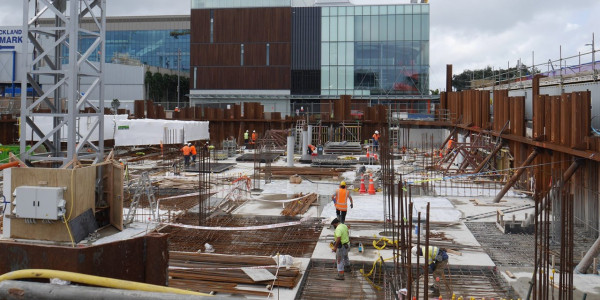

In an initiative to return 1,100 staff from thirteen government agencies to central Christchurch by the end of 2016, the Christchurch Integrated Government Accommodation project saw four new buildings...
In an initiative to return 1,100 staff from thirteen government agencies to central Christchurch by the end of 2016, the Christchurch Integrated Government Accommodation project saw four new buildings built near the proposed Retail Precinct in the CBD.
One of these was Grand Central – a seven-storey structural steel framed building on base isolators on the site of the former Hotel Grand Chancellor. We constructed the base build and extensive glass façade. A separate contract was let to fit out the office space for three government agencies: the Ministry of Business, Innovation and Employment (MBIE), the Department of Conservation and the Ministry of Social Development. Fletcher also had the contract for the fitout for MBIE.
The design of this retail and office complex was an exemplar for government and commercial accommodation in Christchurch – a ‘mixed-use development’ for multiple agencies, ideal for improved collaboration among building users, but also made best use of space, services and resources.
Unique aspects include:
Large floor plates offer flexible, new generation workplace opportunities for more than 1,000 people in the heart of Christchurch’s central city. The development provides connected workspaces via an open central atrium. High ceilings and interconnecting open stairs link the office floors, allowing tenants to work across multiple levels. These connections will inspire people to engage with each other, fostering better productivity.
The building’s state-of-the-art features provide maximum benefit to building users from the base isolation system with a high tolerance for shaking forces, to the double-glazed curtainwall façade specified to let in natural light and reduce solar gain.
We worked with the design team for eight months prior to construction, providing advice on buildability, programme and safety in design.
| Client | GCNZ |
|---|---|
| Budget | $70 million |
| Completed | November 2016 |
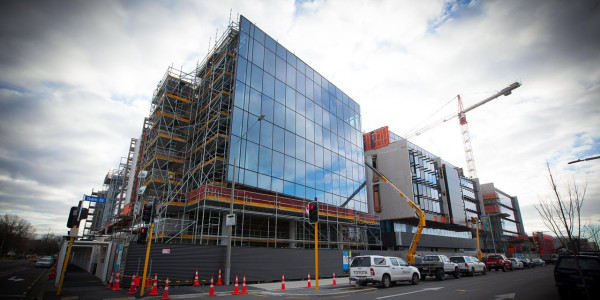

When its Engineering School suffered extensive structural damage in the 2011 earthquake, the University of Canterbury faced the same dilemma as property owners across the city: demolish and start agai...
When its Engineering School suffered extensive structural damage in the 2011 earthquake, the University of Canterbury faced the same dilemma as property owners across the city: demolish and start again, or repair and retrofit the damaged structure?
Consultants initially advised on mimicking the existing foundations by installing a shallow pad to the gravel bearing layer, but this would have required extensive dewatering, creating settlement risks and undermining the structure to create further damage.
Screw piling presented a viable alternative option due to the smaller plant used (enabling large piles to be installed without further damage to the building) so Piletech was approached to develop an alternative foundation solution. After feasibility studies and load tests, Piletech developed a commercially viable solution that also significantly reduced the client's risk profile.
Piletech worked with main contractor Hawkins over two years to install 396 piles with multiple helices to depths of around 12m to support the building – and get the Engineering School back up and running.
| Client | University of Canterbury |
|---|---|
| Budget | $2 million |
| Completed | October 2016 |
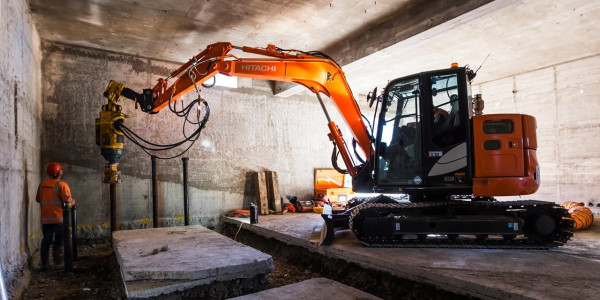

Creative spaces foster creative thinking, so the University of Auckland sought a vibrant, collaborative learning environment for their new science centre.
Creative spaces foster creative thinking, so the University of Auckland sought a vibrant, collaborative learning environment for their new science centre. We were engaged to bring the highly distinctive design by Architectus to life.
The 38,000m2 new facility on Auckland’s Symonds Street replaced the former 1960’s era Science Building (also built by Fletcher). Housing scientists, other academics and professional staff, it comprises cellular offices, distributed plant rooms, teaching rooms, general and specialist laboratories, workshops and ancillary spaces.
The cornerstone of the building is an 11-storey tower with a stunning glass façade, creating a fitting gateway to the university campus.
Demolition of the 1960’s building took six months to complete and employed the largest freestanding tower crane in the southern hemisphere. At 93 metres to the very top, and 79 metres under the hook, the crane took almost three days to erect.
The existing buildings remained occupied during demolition and throughout construction, requiring intricate staging plans.
As the project was undertaken within an operational university, careful liaison was required with students, staff and the public.
| Client | University of Auckland |
|---|---|
| Budget | $145 million |
| Completed | October 2016 |
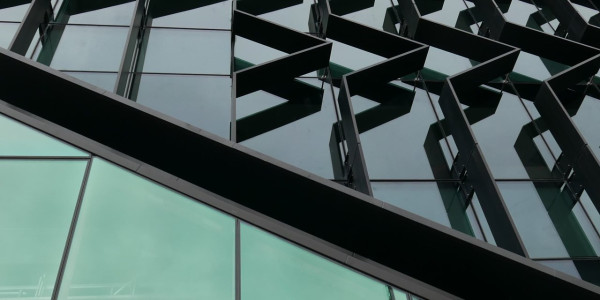

The interior of the University of Auckland’s new 38000m² Science Centre is as vibrant as its exterior, with high ceilings, collaborative spaces and natural timber accents.
The interior of the University of Auckland’s new 38000m² Science Centre is as vibrant as its exterior, with high ceilings, collaborative spaces and natural timber accents. Forman’s precision and seismic expertise was integral to achieving the clean lines sought by Architectus and accommodating the high level of services required for a research facility.
Forman delivered a range of different ceiling types across the eleven floors of the building, including 8,000 m2 two-way grid and tile, 11,000 cedar battens, 1,800 m2 aluminium grid with Tonga ceiling tiles, 1,100 m2 Armstrong Metalworks metal tile for labs, and 1,100 m2 Alumacoust Mark II linear slat ceiling system.
Fletcher and Forman designed an innovative aluminium grid tee system for the corridor ceilings that had a range of benefits: it accommodated both gravity and seismic loads into one system, value-engineered and simplified the original seismic (ceiling) design to deliver savings to the client, created a concealed system for fixing MDF panels that achieved a flush aesthetic in line within Architectus’ requirements and resolved potential clashes between partitions and the ceiling wall angle in a seismic event.
The high level of services required for the laboratory meant conventional seismic braces could not be installed, so Forman developed an innovative means of incorporating seismic bracing.
We also developed an innovative hanging system for the cedar battens which combined bridging around in-ceiling services, seismic and gravity loads. This hanging system allowed us to support the ceiling and maintain clearances from services in accordance with code.
| Client | University of Auckland |
|---|---|
| Budget | $3.5 milliom |
| Completed | October 2016 |
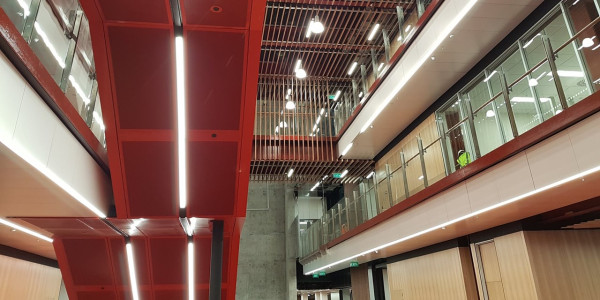

Our work at the Christchurch Arts Centre dates back to 2004 when we undertook strengthening on the Registry Building, and continued in 2008 with the structural strengthening of the School of Arts. Although both buildings suffered some damage during the 2010 and 2011 earthquakes, they stood up much better thanks to those works.
And it was those pre-emptive works that prepared us for our biggest challenge yet: restoration of the iconic Clock Tower and College Hall - some of the oldest and most significant buildings in the town centre. Both were extensively damaged in the September and February earthquakes.
These Gothic structures have been an icon of Christchurch for almost 150 years and restoring them was a privilege. We used a sympathetic construction approach to restore the interior and exterior of these Category One listed heritage buildings, so that when the centre re-opened in mid- 2016, the works were imperceptible.
| Client | Arts Centre of Christchurch |
|---|---|
| Budget | $130 million |
| Completed | June 2016 |





After securing a significant 10-year gas supply contract, Todd Energy embarked on a five-year expansion project at the Mangahewa Gas Field in North Taranaki in 2011.
After securing a significant 10-year gas supply contract, Todd Energy embarked on a five-year expansion project at the Mangahewa Gas Field in North Taranaki in 2011.
With its multi-million dollar plant on its way by cargo ship, Todd Energy approached Piletech to develop an appropriate foundations solution. Piletech was engaged under an early contractor involvement model to help manage the ground risk and develop the most efficient design.
Challenging ground conditions were just one concern: a live high pressure methane line ran adjacent to the new construction site. With the catastrophic effects of any disruption to the pipe, a low-vibration piling methodology and impeccable installation approach was essential.
Piletech adapted standard working methodologies to effectively eliminate or significantly isolate large portions of construction risk. Rigorous safety procedures enabled Piletech to install the 91 piles (to depths of nine to twelve metres) safely and to a short seven-day programme.
| Client | Todd Energy |
|---|---|
| Budget | $500,000 |
| Completed | April 2016 |
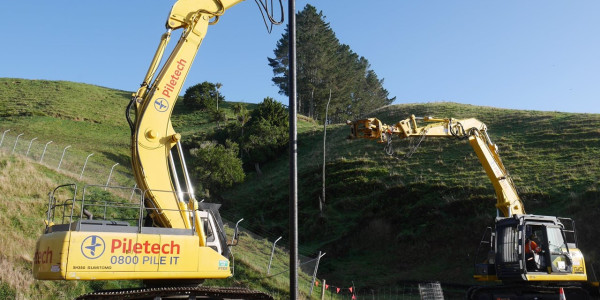

With a vision to bring people back into central Christchurch following the 2010 and 2011 earthquakes, Fletcher Living partnered with MBIE (Ministry for Building Innovation and Employment in New Zealan...
With a vision to bring people back into central Christchurch following the 2010 and 2011 earthquakes, Fletcher Living partnered with MBIE (Ministry for Building Innovation and Employment in New Zealand) to redevelop the old Atlas Foundry in Welles Street, close to the Christchurch Central Business District, into a medium-density residential development.
Designed to be a vibrant new community, the redevelopment includes 191 new homes, a mix of apartments and terraced housing.
Early involvement was crucial to developing a cost-effective solution.
Challenging ground conditions necessitated a well-considered foundation solution, so Fletcher Living engaged Piletech and Brian Perry Civil during the tender phase to identify the right approach. This early involvement was crucial to developing a cost-effective solution. Piletech’s long-standing relationships in Christchurch also played a key role in the selection of the structural consultant to design the project, Aurecon.
Piletech undertook a range of multiple load tests for compression and tension before recommending the final solution. The load tests not only provided surety of our design, but also vastly reduce the overall piling costs.
The solution chosen was installation of more than 330 screw piles, split between three buildings, to depths of up to 29 metres. In total, 4.2 km of pipe was installed. This pipe was filled with 190m3 of concrete and 2,514 metres of reinforcing was installed.
| Client | Christchurch City Council |
|---|---|
| Budget | $2.2 million |
| Completed | March 2016 |
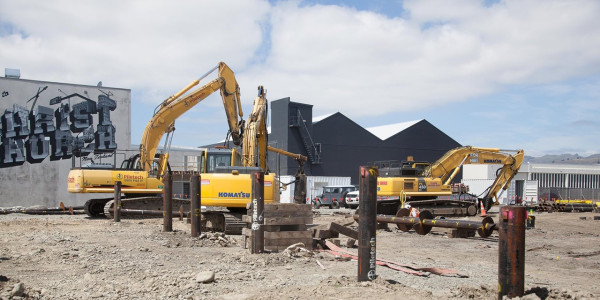

Waikato University’s new Law and Management School building has clean lines and a sleek modern design that make it both a stimulating learning environment and a fitting gateway for the University’s Ha...
Waikato University’s new Law and Management School building has clean lines and a sleek modern design that make it both a stimulating learning environment and a fitting gateway for the University’s Hamilton campus.
The new building has a five-storey office tower and rooms below-ground level with a feature ‘living lawn’ roof. The tower features vertical sunshade vanes to symbolise the tukutuku reed panels of a traditional meeting house, natural ventilation and glazed corridor walls for natural lighting. Constructed using steel, glass and concrete precast panels, the facility houses teaching spaces, offices, a boardroom, computer labs, student services and reception areas, as well as a moot courtroom.
The 6,000m2 facility is an extension to the existing management school faculty building and was designed as three separate structures connected by expansion joints: podium building, tower and new MSB building. The living green roof links the three buildings together, creating an outside space where students can circulate and relax.
The building’s location in the centre of an operational university required a careful construction approach to minimise disruption to students and staff.
The outside façade is made of 80 lightweight precast pumice panels, which are just 60% of the weight of standard precast panels.
The apparent simplicity of the design belies the complexity of its construction and achieving the characteristic clean lines required a very high level of precision. The impressive areas of exposed concrete walls and floors required significant effort to ensure that the desired architectural effects were realised.
| Client | Waikato University |
|---|---|
| Budget | $28 million |
| Completed | March 2016 |
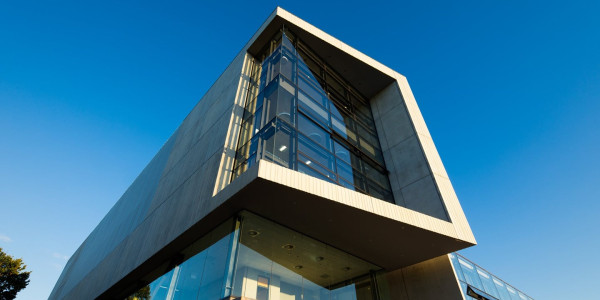

High ceilings are a hallmark of David Jones stores, so when the Australian retailer converted Wellington institution Kirkcaldie and Stains into their first international outlet, Forman’s suspended cei...
High ceilings are a hallmark of David Jones stores, so when the Australian retailer converted Wellington institution Kirkcaldie and Stains into their first international outlet, Forman’s suspended ceilings expertise was sought.
Forman constructed high quality ceilings throughout the perimeter of the top level of the store, including a striking curved helical ceiling in the restaurant area. To create the feeling of a bright, vibrant store, the ceilings featured a large amount of recessed lighting details with long straight edges, spot-lit from all angles. The unforgiving shadows this created demanded a perfect finish.
The original lighting bulkhead design was based on Gib, however Forman constructed a full-size model of the recessed lights to demonstrate the limitations of using just Gib and showcase how fibrous plaster would produce a much better quality. This was accepted by David Jones and incorporated into the construction design.
The conversion of the heritage-listed building was delivered to a very tight, 115-day programme to meet David Jones’ planned opening dates, requiring careful planning and coordination.
By linking the services installation with our engineered seismic design we ensured that all pieces of the puzzle went together first fit – avoiding costly, time-consuming clashes to service heights and placements.
| Client | LT McGuiness |
|---|---|
| Budget | $500,000 |
| Completed | February 2016 |
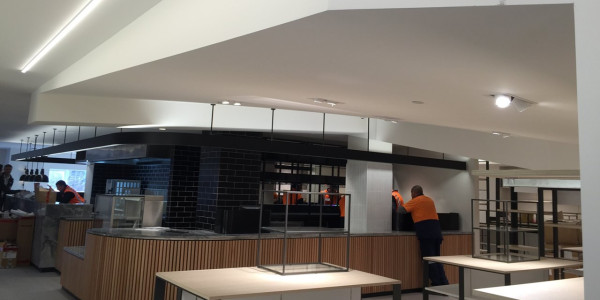

Located opposite the verdant Victoria Park on a large site bordered by Fanshawe, Halsey, Gaunt and Daldy Streets, the new Fonterra head office was jointly developed by Fletcher Building and Goodman Property. We were involved from the outset of the project, providing project planning and preconstruction advice before constructing this building as the first stage of a multi-building precinct development.
The seven-storey, 16,000m2 Fonterra building included an additional basement level carpark (accessed via the neighbouring VXV3 building carpark, which is a four-level basement structure, also being built by Fletcher). The building design responds to Fonterra's environmentally conscious and sustainable approach to business, with environmental initiatives such as: grey water harvesting, a highly-engineered building façade to optimise natural light and occupant comfort and minimise energy use, external 'green walls' spanning the full height of the building and energy-efficient lighting and air conditioning.
The building design responds to Fonterra's environmentally-conscious and sustainable approach to business.
Office floor plates have a net lettable area of between 2,050m² and 2,350m², with a central atrium space with shifting voids and atrium edge conditions at each level. This premium-grade office space boasts regular and contiguous floor plate design, along with minimal column interruption.
Our work scope also included precinct laneways and a plaza to be utilised by all tenants of the precinct and the wider public. This plaza includes reed-bed gardens and a combination of cast in-situ concrete and trafficable desking timber, all built over a vehicles tunnel leading to the underground car parks.
| Client | Fletcher Building/Goodman |
|---|---|
| Budget | $100 million |
| Completed | January 2016 |
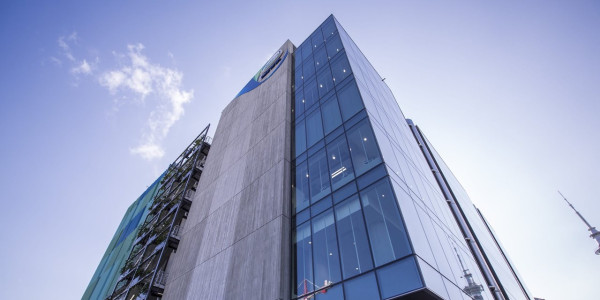

Software developers Sandfield sought a vibrant space to reflect their innovative business approach when they fitted out their new headquarters in Ponsonby.
Software developers Sandfield sought a vibrant space to reflect their innovative business approach when they fitted out their new headquarters in Ponsonby.
Forman worked with architects Archimedia and specialist metal manufacturer Metal Concepts to develop a custom-designed ceiling for Sandfield that reflects the directional idea of a waka or wave. The 450m2 ceiling consists of 255 individual perforated anodised aluminium triangle ceiling panels, bolted together in clusters of four or five panels to form 66 large panels up to 5.5m in length.
The complex design required Forman to continually think outside the square in installing the ceiling.
Each ceiling panel was hung at its own specific angle. The result of this design detail was that every time four points of the different triangle panels came together, they formed a low or high point in the ceiling. This resulted in the ceiling creating 198 different ceiling heights / set-out points for its installation.
Identifying a means of fixing all the individual panels together during installation (including coordinating the restraining of the ceiling panels and the services to meet the seismic requirements of NZS 1170.5 and NZS 4219) was a significant challenge. Forman was awarded a contract variation to brace air conditioning, lighting and services as well as the ceiling installation. By enabling greater coordination between activities, this greatly reduced the programme for the main contractor and ensured a full compliant finished product for the architect and building owner.
Maintaining access to building services was a significant challenge. Forman developed a custom-designed hatch solution, whereby the large ceiling panels detached from the seismic grid and safely dropped 1.15m via restraint chains to allow access for service technicians.
| Client | Canam Interiors |
|---|---|
| Completed | January 2016 |
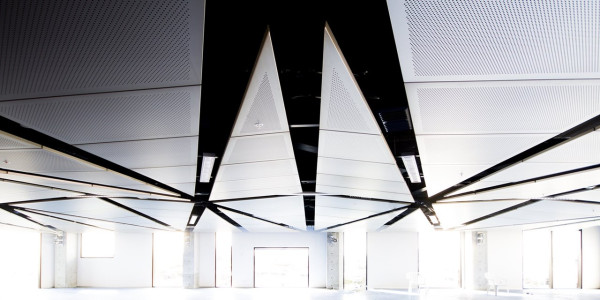

Space in central Auckland is at a premium, with major construction projects underway right across the city.
Space in central Auckland is at a premium, with major construction projects underway right across the city.
Dominion Contractors needed a strong foundation to support their tower crane for a commercial building project in the CBD. A piled rather than pad foundation was required to provide the requisite capacity, but with the planned route for the City Rail Link running directly below the site, the piles had to be easily retrievable - meaning bored piles were not an option either. Having worked with Piletech before, Dominion approached us to develop a screw piling foundation solution.
Piletech designed a significantly loaded screw pile solution which included a unique screw pile connection detail. The connection eliminated the need for concrete curing and allowed Dominion to immediately erect the tower crane once the piling was complete – accelerating their construction programme.
The smaller, nimbler plant used for screw piling was another key benefit on the 'postage-stamp'-sized site – enabling the piles to be installed (and later removed) without disrupting other trades and without the need for major traffic management.
| Client | Dominion Contractors |
|---|---|
| Budget | $100,000 - $200,000 |
| Completed | December 2015 |
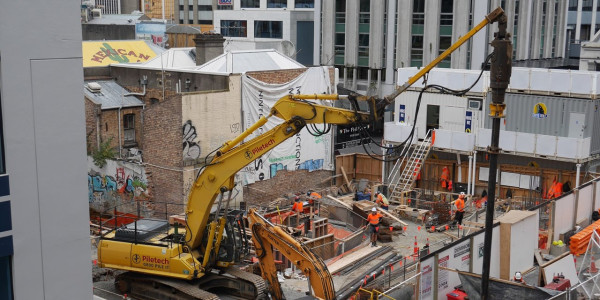

Bringing resort-style gaming to Honiara, the South Seas Casino & Resort has become a favourite with tourists and business customers since opening in late 2015.
Bringing resort-style gaming to Honiara, the South Seas Casino & Resort has become a favourite with tourists and business customers since opening in late 2015.
The first in a three-stage development for Honiara Resort Solomon Islands, the complex includes a two-storey casino (boasting 64 slot machines and 26 gaming tables), along with a 52-seat restaurant and outdoor swimming pool.
Designed to reflect its exotic surroundings and maximise views of the Pacific coastline, the casino was constructed using a combination of hardwood joinery and structural steel, with precast panels forming the external walls. Joinery was manufactured in our Papua New Guinea joinery factory. Sourcing the structural steel from China resulted in significant cost benefits for the project, and the precast wall panels were batched and poured on site to ensure the stringent quality standards were met.
Client satisfaction with delivery of the project saw Fletcher awarded further stages of the project, initially for a 35-room accommodation wing and 5 “high roller” luxury villas at the resort.
| Client | Honiara Resort Solomon Islands Resort Limited |
|---|---|
| Budget | $9.2 million |
| Completed | October 2015 |
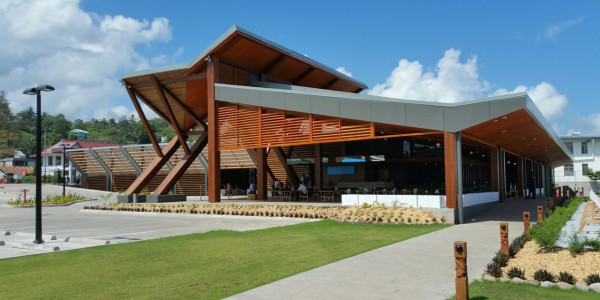

We delivered two international-level sporting facilities in Port Moresby, Papua New Guinea to host the 15th Pacific Games: an upgrade to the 20-year-old Sir John Guise Stadium and the 15,000m2 new-bui...
We delivered two international-level sporting facilities in Port Moresby, Papua New Guinea to host the 15th Pacific Games: an upgrade to the 20-year-old Sir John Guise Stadium and the 15,000m2 new-build Taurama Aquatic Centre and Indoor Sports Complex.
The refurbished Sir John Guise Stadium meets international standards for track and field events and the existing 900 seat grandstand was expanded into a 15,000-seat complex. We also converted the stadium complex into changing rooms, warm up areas, and corporate lounges.
The Taurama Aquatic Centre and Indoor Sports Complex provides sporting facilities to international competition standards for swimming, volleyball, basketball and a variety of other indoor sports. The complex includes a stainless steel Olympic-standard 50m competition pool with a movable bulkhead to shorten the pool to 25m for international standard short course competition; a separate 25m warm up pool; 6 Olympic standard volleyball / basketball courts with movable spectator seating for up to 2,500 people in the ‘centre court’ arrangement; two multipurpose studios; corporate entertainment areas and a generous gymnasium for athletes to train in.
All facilities were built to very exacting requirements to comply with international sporting specifications. Both the Sir John Guise Stadium and Taurama Aquatic Centre are now used as community sporting facilities following the completion of the games.
| Client | Venue Infrastructure & Equipment Committee PNG 2015 Pacific Games |
|---|---|
| Budget | $215 million |
| Completed | June 2015 |
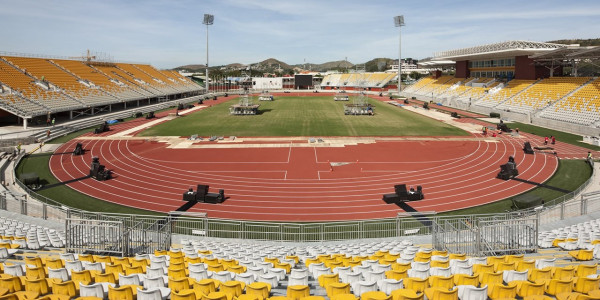

The Christchurch Memorial Returned and Services Association is New Zealand’s first and oldest RSA, formed in 1915 by Veterans from Gallipoli and the other battlefields of Word War 1.
The Christchurch Memorial Returned and Services Association is New Zealand’s first and oldest RSA, formed in 1915 by Veterans from Gallipoli and the other battlefields of Word War 1. When the association’s headquarters were irreparably damaged during the February 2011 earthquakes, Fletcher was engaged to deliver a state-of-the-art new home for the RSA in time for the WWI centenary celebrations in April 2015.
Forman delivered the striking Radiata ceilings which are key a feature of the new headquarters.
Decortech Firesafe Radiata SD Plywood prefinished Multigroove plank panels of 17mm thickness were used. The Decortech was fixed to Rondo battens at predetermined positions. Lighting and services trays were also installed between panels.
Due to the non-negotiable opening date, the project was delivered to a very tight programme, requiring a change in construction approach for the ceiling works. Service penetrations are typically predrilled in the factory environment, but due to the high number of penetrations and the compressed build schedule, these works were undertaken in situ instead.
Forman’s coordinated and systematic approach was essential to completing the services drilling work right first time. Quality assurance was the major risk of prefabrication and cutting, due to the high number of services penetrations and the difficulties in the set out (in particular, the raking ceilings). Through careful planning and extensive liaison, Forman was able to complete the drilling with minimal rework to the panels.
| Client | Christchurch Returned Services Association |
|---|---|
| Completed | March 2015 |
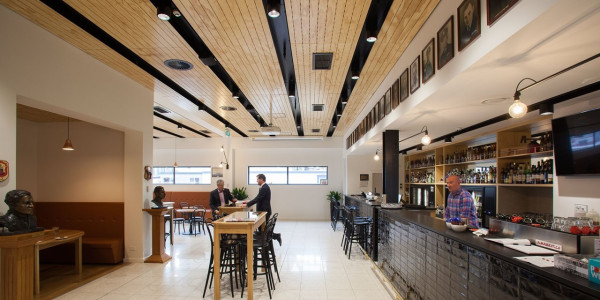

When the Ministry for Culture & Heritage engaged us to undertake the seismic strengthening and refurbishment of the art deco Carillon and Category 1 Heritage listed Hall of Memories, they set a very c...
When the Ministry for Culture & Heritage engaged us to undertake the seismic strengthening and refurbishment of the art deco Carillon and Category 1 Heritage listed Hall of Memories, they set a very clear objective: the visual impact of the works should be imperceptible.
To meet this challenge, we used a sympathetic construction approach to restore and strengthen these nationally significant monuments.
Restoration and seismic strengthening of the building included supporting the building by tying buttresses to beams under the steps on either side of the building.
On the north side of the hall, blocks of the creamy white Mount Somers stone that clad the building’s interior were tied to the reinforced carillon wall with 300 steel rods. The drill holes were filled with ground-up stone so that the repairs are barely evident.
The seismic upgrade, safety and heritage retrofit of the National War Memorial Carillon included installation of new seismic braces and construction of new seismic walls to the Clavier Room, replastering the exterior tower, repairs to the roof, windows and balustrades, upgrades to the Crow’s Nest and more than 100 individual concrete repairs and repainting.
Other building work included the installation of safety nets and the relocation of electrical and stormwater services.
| Client | Ministry for Culture and Heritage |
|---|---|
| Budget | $2.7 million |
| Completed | February 2015 |
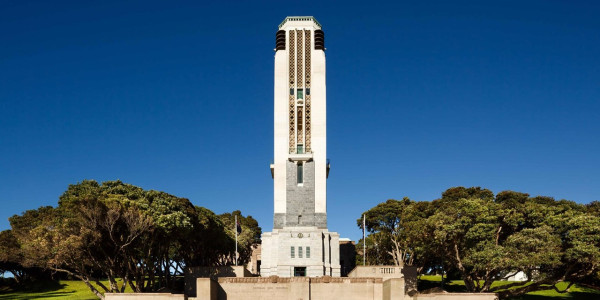

We were responsible for the design and construction of the 49,090m2 facility, which reflects international best practice in design and operation.
We were responsible for the design and construction of the 49,090m2 facility, which reflects international best practice in design and operation.
The high security facility consists of three house blocks for 720 prisoners and 10 residence buildings for the remaining 240 men. Each residence unit accommodates six men who, through better behaviour, have earned the right to live there. While housed in more domestic buildings, they will take more responsibility for their day-to-day arrangements including budgeting, meal planning, cooking and doing their own laundry.
The prison is designed so that once prisoners are processed through the gate house they are challenged to change their lives for the better and become constructive members of society. Their first home will be House Block 1 which is furthest from the gate. In all cases, prisoners will be housed in accommodation appropriate to their security rating. This is all part of the focus to encourage prisoners to take personal responsibility for their actions, and thus be better prepared to leave and contribute positively to communities.
The facility comprises 32 buildings in total including the Whare Manaaki and Fale Pasifika (cultural centres for Māori and Pasifika prisoners) and large industrial buildings to accommodate vocational and training facilities.
The project’s unique aspects include up to 900 people on site each day and strict access protocols due to the close proximity of the operating Auckland Region Women’s Corrections Facility and Youth Justice facility, Korowai Manaaki.
Close collaboration between the project partners generated cost-effective solutions that provided excellent durability, robustness, and whole-of-life operational efficiency. These considerations influenced significant decisions around choice of materials, equipment selections and overall planning and operation of the prison.
| Client | SecureFuture SPV for Department of Corrections |
|---|---|
| Budget | $270 million |
| Completed | January 2015 |
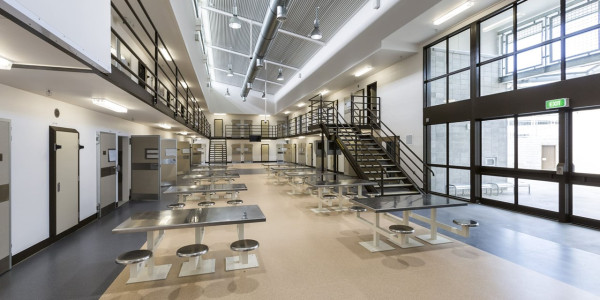

With state-of-the art equipment, photovoltaic panels and a living green wall, the Kathleen Kilgour Centre is one of the most sophisticated health care facilities in the country, with comfort an import...
With state-of-the art equipment, photovoltaic panels and a living green wall, the Kathleen Kilgour Centre is one of the most sophisticated health care facilities in the country, with comfort an important feature.
Although it's a medical clinic, the three-storey, 3,000m2 building is designed to provide a comforting experience for patients, with a welcoming, non-clinical atmosphere.
The ground floor provides consultation rooms, waiting rooms, a CT scanner room and three linear accelerator rooms for radiotherapy treatment. These treatment rooms are like bunkers cut into the side of the sloping site, partially underground. The bunkers contained 1,040m³ of concrete, with 258 tonnes of steel plate buried within the walls and roofs to prevent radiation leakage from the machines.
The second floor is a car park for patients (another initiative in making their visits less stressful), and the third floor consists of offices and consulting rooms.
Photovoltaic cells on the building’s roof offset the energy consumption of the machines used for treatment. Shaded windows reduce glare while providing natural light and reducing the need for artificial lighting. A stormwater retention system used in the bathrooms reduces water usage, and a 14 metre high living green wall (containing 3,780 plants) improves indoor air quality and softens the patient experience.
| Client | Kathleen Kilgour Centre Limited Partnership |
|---|---|
| Budget | $19 million |
| Completed | December 2014 |





Whakatane Hospital was opened by Sir Maui Pomare, one of New Zealand’s first Māori doctors, in 1923.
Whakatane Hospital was opened by Sir Maui Pomare, one of New Zealand’s first Māori doctors, in 1923. By the early 2000’s, the hospital was no longer meeting patient needs and Bay of Plenty District Health Board embarked on a major redevelopment programme to improve patient experiences and future-proof the hospital for the next 40 years.
We delivered Project Waka, a $67 million contract for a new 8,500m2 single-level general hospital built within the confines of the existing hospital campus. The standalone facility includes operating theatres and associated support areas, an ED, Radiology Departments, paediatrics and acute services together with wards totaling 100 beds for surgical and medical patients.
We used a modular construction approach to build the new facility with square-shaped structures pieced together. Different squares provide different clinical functions for the hospital, and all squares are arranged around a central open courtyard.
The final layout of departments was arranged to ensure seamless access between different areas. For example, reduced pathways for patients and staff moving between diagnostic services and treatment areas. The single-level design eliminates the need for patients and staff to climb stairs or enter and exit elevators. To ensure spaces meet the needs of both staff and patients, hospital staff participated in the building’s detailed design phase.
| Client | Bay of Plenty District Health Board |
|---|---|
| Budget | $67 million |
| Completed | May 2014 |






The Hawke's Bay Regional Sports Park International Hockey facility is New Zealand’s first and only Tier 1 Hockey facility.
The Hawke's Bay Regional Sports Park International Hockey facility is New Zealand’s first and only Tier 1 Hockey facility.
Higgins designed many aspects of this park to ensure it met the standards of international teams and broadcasters, and delivered the project on time within a compressed 20-week timeframe before the first International Festival of Hockey in April 2014.
Higgins Role:
- Re-design of the international pitch to allow for flatter grades and porous pavement.
- Excavated and constructed hard stands from greenfields for the turf foundations.
- Installation of subsurface drains in the porous turf.
- Design of the international pitch lighting for broadcasting to ensure Lux was acceptable for international HD Broadcast.
- Construction of concrete flood light foundations up to 5 metres deep by tremmying.
- Design and construction of viewing tower out of modified shipping containers including fibre optics and power for network connections to allow immediate play back to coaches and players in the dug outs.
- Construction of players dug outs.
- Construction of concourse, footpaths and associated amenities.
The Hawkes Bay Sports Park Hockey Facility project was completed to very high standard, meeting the Tier 1 International standards for the hockey (FIH) and was completed on time for the Hawkes Bay International Festival of Hockey.
| Completed | March 2014 |
|---|
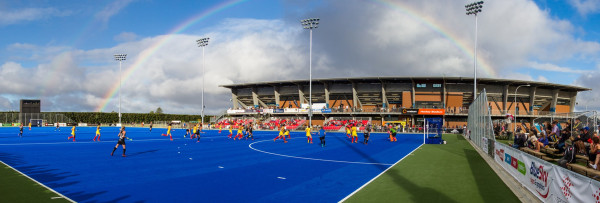

Christchurch’s health care services took a hammering from the 2010 and 2011 earthquakes, with widespread damage to both public and private facilities resulting in a severe shortage of beds.
Christchurch’s health care services took a hammering from the 2010 and 2011 earthquakes, with widespread damage to both public and private facilities resulting in a severe shortage of beds. Ongoing aftershocks hampered repair works, placing further strain on an already pressured system. We worked with both Canterbury District Health Board and private providers to get their facilities back up and running as fast as possible.
The state-of-the-art new Forté Health medical centre, built to replace the earthquake-damaged Oxford Clinic, is just one example. The three-storey health care facility houses four operating theatres and associated recovery and consulting rooms.
Designed to withstand a one-in-2,500-year earthquake, the Importance Level 4 building is the first New Zealand application of Precast Seismic Structural System (PRESSS) technology in steel construction. The piles are as deep as the height of the hospital and its interlocking steel frame is designed to move and absorb energy in a large earthquake. In a major disaster the hospital would be back up and running very quickly and could provide facilities for public healthcare.
A contemporary, highly-glazed façade provides natural light and expansive views from inside.
The first Green Star building completed in central Christchurch since the earthquakes, Forté Health is also NZ’s first Green Star medical centre and one of only three Green Star health buildings.
| Client | Nobby Holdings Limited |
|---|---|
| Budget | $27 million |
| Completed | December 2013 |
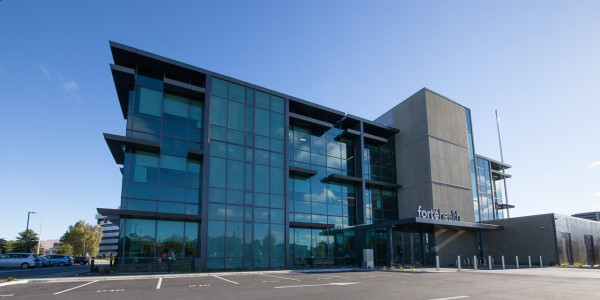

Kiwi Property Trust had a bold vision for their anchor project in Auckland’s Wynyard Quarter: a building that is leading-edge both in terms of workplace design and environmental sustainability. Long-term tenants ASB sought a state-of-the-art head office that reflects the world-class service they provide to their customers, employees and the community.
| Client | Kiwi Income Property Trust / ASB |
|---|---|
| Budget | $105 million |
| Completed | January 2013 |




Reflecting AUT’s position as ‘The University for the Changing World’, the Sir Paul Reeves Building is designed to reflect the latest thinking in educational architecture, with flexible working spaces ...
Reflecting AUT’s position as ‘The University for the Changing World’, the Sir Paul Reeves Building is designed to reflect the latest thinking in educational architecture, with flexible working spaces that promote collaboration and innovation.
Named for former Chancellor Sir Paul Reeves, who was instrumental in establishing the current direction, spirit and prestige of the University, the 20,000m2 building features one of the most modern media teaching and learning spaces in the Southern Hemisphere.
Key features of the facility include a 12-storey tower, glass-roofed atrium and green quad, while the Governor Fitzroy Plaza provides connections with the surrounding buildings, including the Faculty of Business and Law School. The atrium and linkages are supported by structural steel; work of varying complexity incorporating the full gambit of steel construction detailing.
With an emphasis on collaborative learning, all lobbies and break-out spaces feature open-plan study areas to prepare students for modern work environments. High-efficiency heating and air-conditioning, low-energy lighting and long-life materials also contribute to the visionary design and function of the buildings.
Constructed in a live campus adjacent to busy public areas and roadways, the project required careful liaison with University operational staff.
| Client | Auckland University of Technology |
|---|---|
| Budget | $75 million |
| Completed | November 2012 |





With its rich natural resources drawing commercial interest from all over the world, Papua New Guinea needed a premium hotel in downtown Port Moresby to host its global business customers.
With its rich natural resources drawing commercial interest from all over the world, Papua New Guinea needed a premium hotel in downtown Port Moresby to host its global business customers. A high-end hotel would also support the country’s growing tourism industry.
From the moment it opened its doors, the Grand Papua Hotel has been a favourite of both business customers and tourists. Built on the same estate as the original Papua Hotel, it is the tallest building in Papua New Guinea.
The 70m high, 21-storey hotel comprises 161 rooms and suites, in addition to the Grand Bar & Brasserie, the Grand Spa & Beauty Salon and the latest in conference facilities with two levels of meeting space and an expansive Executive Lounge with private boardrooms. The contemporary colonial interior features design elements that reflect the diversity of PNG's cultures.
The four basement areas house conference facilities, a spa area and hair salon as well as car parking facilities.
We used an innovative post-tensioned floor system for the first time in Papua New Guinea, which saw the floors constructed faster, using less labour and materials. The post-tensioned system essentially eliminates the need for beams to hold up the floor, and the associated extra formwork or reinforcing steel. It also allows clear ceiling space for services installation – producing valuable cost savings.
| Client | Steamship Property Division |
|---|---|
| Budget | $60 million |
| Completed | November 2011 |
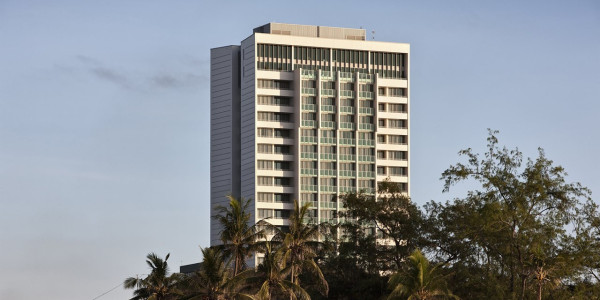

One of Christchurch’s oldest and grandest homes, Te Koraha, was built in 1886 by former Christchurch mayor Arthur Rhodes.
One of Christchurch’s oldest and grandest homes, Te Koraha, was built in 1886 by former Christchurch mayor Arthur Rhodes. In 1923, it became the home for students and staff of girls school Rangi Ruru, providing boarding accommodation for up to 180 girls at a time, for nearly 80 years.
When the Tudoresque homestead was severely damaged during the 2011 earthquakes, we were engaged to repair and bring the vast, two-storeyed timber house up to the new building code. Piletech played an integral role in the rehabilitation works installing new piles around the Category 2-listed heritage building, which were then used as support to underpin and re-level the structure.
Screw piling was an ideal option due to the low vibration and quiet installation – enabling us to work in close proximity to the existing building without causing further damage to its foundations, and without disruption to students learning in nearby classrooms.
| Client | Rangi Ruru Girls School |
|---|---|
| Budget | $500,000 |
| Completed | September 2011 |
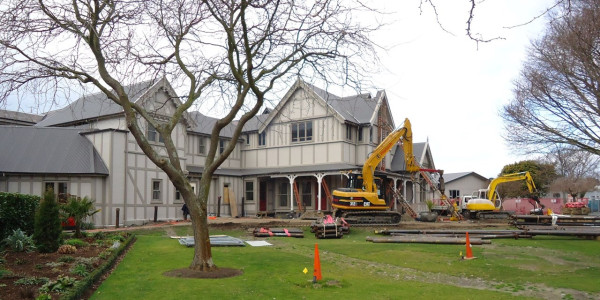

The opening of Apia's Ministry of Education Sports and Culture (MESC) headquarters was a significant milestone for education in Samoa.
The opening of Apia's Ministry of Education Sports and Culture (MESC) headquarters was a significant milestone for education in Samoa. Bringing together all divisions of the MESC for the first time, the state-of-the-art new two-storey headquarters enabled great collaboration in education development.
We built the 3820m2 facility for the Government of Samoa, which comprises two main buildings linked by an air bridge, car parking and a traditional fale for outdoor meetings and important ceremonies. With a contemporary take on traditional Samoan design, the building features extensive timber detailing to a façade that acts as both decoration and protection from the elements. The building structure is a reinforced concrete frame with in-situ concrete floors and a steel portal frame roof support with corrugated roofing. For the first time in Samoa, we installed solar power photovoltaic panels and a Corten steel façade to the building.
Another key feature of the headquarters is the Information and Communication Technology (ICT) Distance Learning Studio, which allows children in remote areas to link to teaching and educational materials they wouldn't otherwise have access to.
| Client | Government of Samoa |
|---|---|
| Budget | WST22.4 million |
| Completed | October 2010 |





As New Zealand's largest rugby and cricket stadium, Eden Park has constantly been at the forefront of our nation's big sporting events.
As New Zealand's largest rugby and cricket stadium, Eden Park has constantly been at the forefront of our nation's big sporting events. In anticipation of the 2011 Rugby World Cup, venue organisers wanted extensive redevelopment that would transform Eden Park beyond simply a sporting venue to an experience.
By world standards, the 45,000-seating capacity was much too small for a World Cup final. Facilities, including service areas and kitchens, needed improvements. Crowd pressure on adjacent streets had to be managed effectively, a greater seating capacity had to be built, and all within a venue that remained in full use.
We began work on the extensive redevelopment in May 2008. A new six-level 21,500-seat South Stand and temporary seating on the east and west stands lifted seating capacity to 60,000. New corporate boxes, media and player facilities, extensive service areas, kitchens, food and beverage outlets, office space and lounges were also built.
The capacity to manage the movement of crowds both within and beyond the stadium was another fundamental feature of the mammoth project. A large purpose-built bus hub along with new and improved linkages to the rail system was a final drawcard in bringing the “park back to Eden Park”.
| Client | Eden Park Redevelopment Board |
|---|---|
| Budget | $150 million |
| Completed | October 2010 |




With its stunning beaches and rich culture, Samoa remains one of the South Pacific’s most sought-after destinations.
With its stunning beaches and rich culture, Samoa remains one of the South Pacific’s most sought-after destinations. Aggie Grey’s Hotel on the shores of Upolu Island is a local icon, hosting thousands of tourists each year.
We designed and built the 140-room, four-star complex for Aggie Grey's Hotel Ltd, which comprises six two-storey accommodation blocks spread out for 500m along the beach to maximise the stunning views. Every hotel room faces the sea with its own verandah overlooking the resort grounds, the lagoon, and towards Savaii Island in the distance.
Extensive covered walkways link the accommodation blocks to a central building with reception lobby, 120-seat restaurant, 50-seat bar, conference facilities, and a traditional Samoan fale. We also built two tennis courts, a 590m² lagoon-side swimming pool, a water sports centre, a gym, a day spa and a traditional wedding chapel on the 40,000m² grounds.
| Client | Aggie Grey's Hotel Ltd |
|---|---|
| Budget | $15 million |
| Completed | March 2005 |
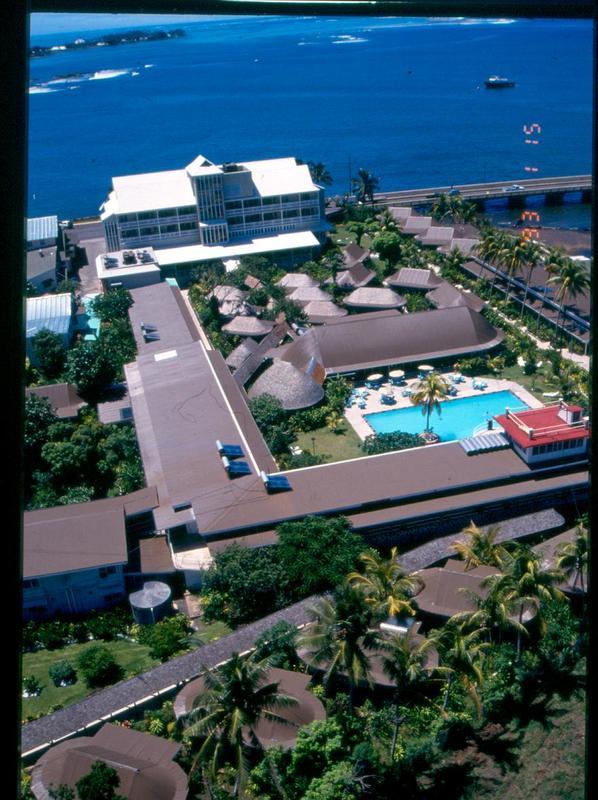

New Zealand’s largest coal terminal, Lyttelton Port, receives coal from the West Coast where it is aggregated and loaded onto vessels for export.
New Zealand’s largest coal terminal, Lyttelton Port, receives coal from the West Coast where it is aggregated and loaded onto vessels for export. With coal trains arriving four to five times per day, and ships leaving approximately every 12 days, an efficient coal-handling system is essential to keep pace with demand.
To increase throughput of coal, we undertook a major upgrade to the coal-handling facility and expansion to the coal storage yard. Our work included construction of a new 2000 tph rail unloader system, installation of a new 1000 tonne stacker-reclaimer system, installation of a new jet slinger (a conveyor belt which carries coal and stacks it into ships for export), extension and reconfiguration of the coal processing yard, installation of new control systems, and an upgrade of the coal dust suppression system and stormwater collection and treatment systems.
The coal-stacker and reclaim system was purchased second-hand by Lyttelton Port Company from the United Kingdom. Our team travelled to Port of Tyne, Newcastle to decommission and disassemble the reclaimer, before shipping it to Lyttelton, where it was recommissioned and upgraded.
The new machinery, along with reconfiguration of the storage yard and improved coal train retrieval facilities, increased the Port’s ship loading capability by 35% from 18,000 tonnes per day to 25,000 tonnes per day. The new dust suppression and stormwater systems significantly reduced the facility’s environmental footprint, while the control systems enabled operations staff to better track its functioning and performance, controlling all aspects of the yard centrally.
| Client | Lyttelton Port Company |
|---|---|
| Budget | $20 million |
| Completed | November 2004 |
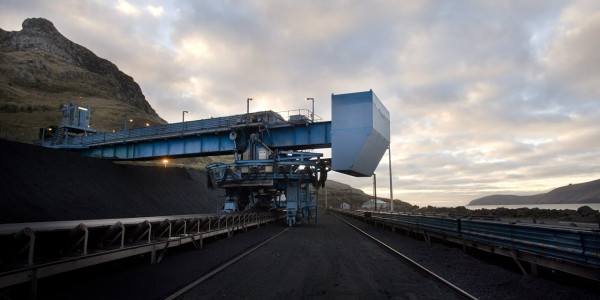

Every aspect of the Auckland City Hospital building is designed to enhance and promote the wellbeing of its occupants – patients and staff alike.
Every aspect of the Auckland City Hospital building is designed to enhance and promote the wellbeing of its occupants – patients and staff alike. We worked with Auckland Healthcare Services over an 18-month preconstruction period to design the hospital around its needs (including creation of a full-sized mockup ward for staff and clinicians to view and comment on), before building the high-tech facility.
As the three hospitals remained fully operational as the new facility was built, we worked with hospital staff to plan and execute all works to prevent any disruption to patient care.
The nine-floor, H-shaped building on a sloping and constrained site features internal courtyard gardens and a glassed atrium link to an existing support building. Strong connections to the outside world were important for both staff and patients so the building maximises natural light. Windows in operating theatres allow staff working long hours to have a sense of their external environment. Windowsills in all wards have been lowered to enable patients to see more than the sky from their beds.
The hospital meets the service requirements of a major facility while providing a calming, healing, friendly environment.
The project included 65,500m3 earthworks, 2700 tonnes structural steel, 11,200m3 concrete, 2,500m framing timber, 530 toilets, 2,500 signs, 2,800 doors, and 19,800 light fittings.
| Client | Auckland Healthcare Services |
|---|---|
| Budget | $181 million |
| Completed | July 2003 |
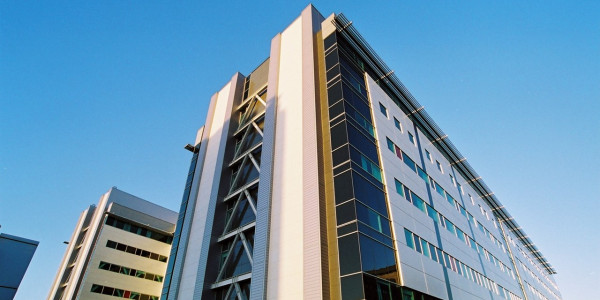

Affectionately known as the ‘Cake Tin’ for its silver coliseum-like shape, Wellington’s Westpac Stadium was built in 1999 to replace rugby’s Athletic Park.
Affectionately known as the ‘Cake Tin’ for its silver coliseum-like shape, Wellington’s Westpac Stadium was built in 1999 to replace rugby’s Athletic Park. Since then, it has hosted many major sporting events and was second only to Auckland’s Eden Park for top fixtures in the 2011 Rugby World Cup.
The first bowl stadium ever built in New Zealand, Westpac Stadium boasts a 34,125sq.m. footprint with an oval accommodating a 133m-long, 70m-wide football field and seating for 34,500 people. Stadium features include 69 corporate boxes, a Sports Hall of Fame, a sports medicine facility, conference rooms, a gallery 13m wide that extends 650m around the arena, sports betting areas, and café-bar and function rooms.
Of note is the 360 degree, 26m-high roof that partially covers the stadium and offers protection to 24,000 spectators in bleacher seating. Lighting for night matches is supplied by four 35m-high lighting towers each equipped with an 88m2 bank of 70 lights.
We were engaged on a preferred contractor basis to provide buildability advice during the design phase, which led to the use of a number of innovative construction techniques including stone column ground stabilisation, lightweight concrete and fabrication of pre-cast concrete bleachers. Following the pre-construction phase, the designers were novated to us.
| Client | Wellington Stadium Development Trust |
|---|---|
| Budget | $98 million |
| Completed | November 1999 |
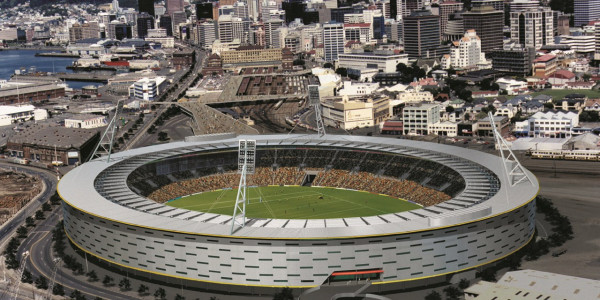

Building the 12th tallest tower in the world – taller than the Eiffel Tower – on schedule, on a site occupying a whole central Auckland block, would have seemed impossible in 1994. Yet we set out to achieve exactly that.
There were plenty of obstacles for our team building Sky Tower (Auckland) to overcome. These included time constraints and innovative design concepts that would allow a 328m tall building to withstand 200km/h winds and resist 8.0 magnitude earthquakes, with efficiency and quality standards. If that wasn’t enough, Sky Tower had to be designed to last 100 years with low maintenance requirements.
Beyond the planning, design and construction effort, more than 15,000 cubic metres of concrete, 2000 tonnes of reinforcing steel and 660 tonnes of structural steel were required to achieve the end goal. At its peak, 1000 building professionals were working on the construction site; what had seemed impossible to others was fast becoming a reality.
When Sky Tower was completed in February 1997, six months ahead of schedule, it was the tallest free-standing structure in the Southern Hemisphere. Sky Tower remains both an enduring icon of Auckland and a visible reminder of an extremely challenging and unique project.
| Client | Sky Tower Casino Ltd |
|---|---|
| Budget | $69 million |
| Completed | February 1997 |



Building Te Papa, The Museum of New Zealand, presented exciting challenges: an unprecedented level of stakeholder expectation and public scrutiny, a location virtually atop a fault line and a build th...
Building Te Papa, The Museum of New Zealand, presented exciting challenges: an unprecedented level of stakeholder expectation and public scrutiny, a location virtually atop a fault line and a build that needed to reflect New Zealand’s history and evolving identity.
By tapping into its deep reservoir of expertise and construction innovations, the Te Papa team project came through. The build saw 150 shock absorbers, made of rubber and lead, placed under the building, providing the public with a building capable of surviving a one-in-500-year earthquake.
Te Papa emerged as a spectacular 30m-high, five-level landmark building featuring an over-sailing roof and a column of elliptical public lounges and galleries. A marae and auditorium capable of seating 300 and 350 respectively were added alongside other education-purposed facilities. Te Papa museum, known locally as ‘Our Place’, has indeed become a place of treasures for all the world to see.
Sir James Fletcher attended the opening ceremony for Te Papa, The Museum of New Zealand, 65 years after the original National Museum was built by his father, Sir James Fletcher (the older).
Around 12,500 masonry blocks, 20,000m3 concrete, and 6000m3 pre-stressed and pre-cast concrete were used in Te Papa's construction.
| Client | Museum of New Zealand |
|---|---|
| Budget | $130 million |
| Completed | June 1996 |
